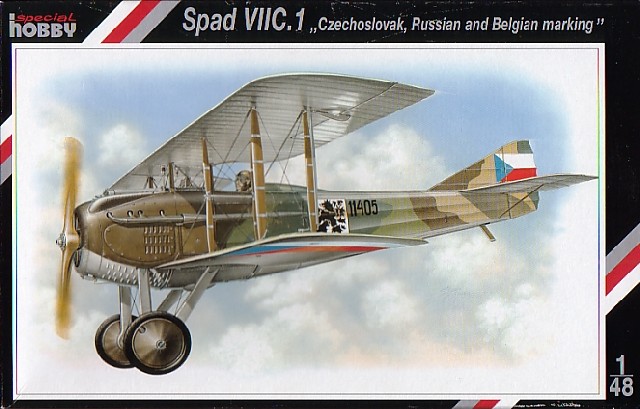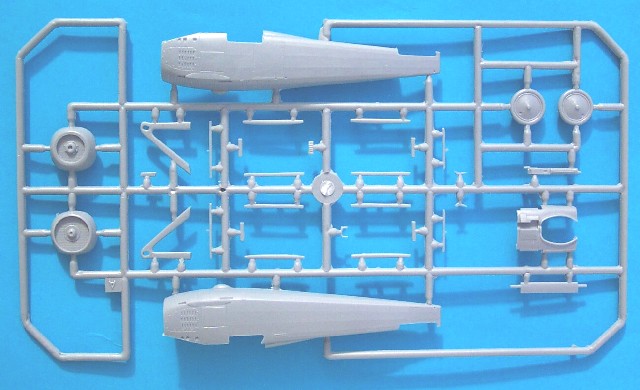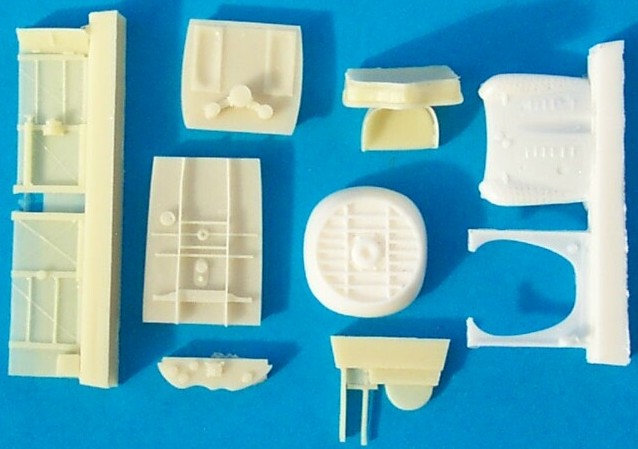|
SPAD S.VII C1
Czechoslovak, Russian and Belgian marking

Special Hobby, 1/48
S
u m m a r y
|
| Catalogue Number: |
Kit No. SO48031 - Spad
S.VII C1 “Czechoslovak, Russian and Belgian marking” |
| Scale: |
1/48 |
| Contents and Media: |
41 plastic parts; 12
parts in resin; 18 photo-etched parts on one fret; markings for three
aircraft |
| Price: |
USD$29.96 from Squadron.com
|
| Review Type: |
FirstLook |
| Advantages: |
Good detail, flawless
resin, useable photo-etched parts, decals in perfect register |
| Disadvantages: |
|
| Recommendation: |
Recommended |
Reviewed by Robert Baumgartner

Special
Hobby's 1/48 scale SPAD S.VII C.1
is available online from Squadron.com
This is another incarnation of the Special Hobby Spad S.VII C1, this
time in the markings used by Czechoslovakia, Russian and Belgian.
There is certainly a lot of kit for your money here. Two sprues of grey
coloured plastic are supplied that contain a total of 41 plastic parts.
To cater for the various options and some of the finer detail, 12 resin
items are provided.
A photo-etched fret gives the modeller an extra 18 parts to play
around with and the vac-formed windscreens, and decal sheets complete
the package.

Click the thumbnails below
to view larger images:
The plastic parts exhibit very fine detail with only a little bit of
flash to clean up. The wings are especially nice with subtle rib
representation and sharp trailing edges. The airframe is representative
of a de Marçay built machine, the prominent features being the large
port access hatch below the cockpit and one smaller one on the starboard
side near the tail.
Two plastic and one resin radiator is provided, the latter “shuttered”
example being for the Czech option.
Other polyurethane parts include the seat/bulkhead, cockpit sides,
floor, and firewall which all combine to form a nice “tub” that is
sandwiched between the fuselage halves.
The characteristic cockpit shelf is also in this medium as is the
instrument panel and upper engine covering.

The photo-etched fret supplies all the fiddly bits that are too
difficult to mould in plastic, such as seatbelts, aileron bell cranks,
various cockpit items and gun sight.
There are a number of General Arrangement drawings available and all
seem to differ slightly in their outlines. One should always be wary of
“just” laying the pieces on top of the ink work but when measured, the
fuselage does appear to be slightly short in length. The offending area
seems to be from behind the cockpit to the leading edge of the
tailplane. Fortunately this does not detract from the overall look of
the completed aircraft.
A couple of vacuum formed pieces of clear plastic give the modeller the
variety of windscreens to cater for the different options. These were
nicely done and my examples were crystal clear.
The instruction sheet gives a basic idea of where everything should go
but the box art will have to be consulted for additional rigging
details.
These decals are as you would expect them to be from this company.
They were in perfect register and have some of the thinnest carrier film
you are likely to see. Despite the apparent fragility, I have never had
a problem applying them.
Two sheets are supplied containing markings for 3 aircraft, as the title
of the kit suggests. It might as well be four because one of the
aircraft can be done in two ways depending on the time of service the
modeller wishes to depict.
Click the thumbnails below
to view larger images:
Option 1
Spad S. VII C1, s/n 11405, Czechoslovakian Air Force, 1922
This is the aircraft as it appeared in 1922 in the above country’s
air service. The only decoration on its camouflaged sides was the serial
number, and the national markings were applied in the usual six
locations.
If the modeller prefers, this aircraft can also carry the roundels that
were present until September 1921. These are also provided on the decal
sheet.
Option 2
Spad S. VII C1, s/n 11405, Czechoslovakian Air Force, 1924
Here we have the same aircraft a couple of years later but this time
wearing the symbol of Air Regiment No.1.
Option 3
Spad S. VII C1, flown by Sous-Lt Charles Ciselet of the 5éme Escadrille
Belge, 1917.
This aircraft carries the unit’s comet emblem in red and white on the
fuselage sides. Additionally it wears two fuselage bands for the
individual pilot’s marking and these were also finished in the above
colours.
Note that this aircraft carries dark green upper surfaces over the usual
yellowish base colour.
Option 4
Spad S. VII C1, flown by Aleksandr Kozakov, 19th Corps Detachment, 1917.
Kozakov’s machine was finished in a single colour of “yellowish-grey”
and had the black skull and cross bones painted on a white rudder. A
nice touch is that the marking is supplied with and without the
background colour, thus easing the painting for some. The front cowl
wears stripes in two colours and these are assumed to be in blue and
gold, the colours of his former cavalry unit. Some publications prefer
blue and red.
Kozakov scored 20 victories although none were in this aircraft. He
preferred to fly a Nieuport 17 so Esaul Shangin used to fly it on many
occasions. In fact Shangin was shot down in this machine in September
1917 fighting the Austro-Hungarians.
As an aside, this is the same Kozakov who lowered an anchor, with gun
cotton attached, from his Morane Saulnier G. This was done in an effort
to entangle it around an enemy aircraft to blow it up!
When he did try this in combat, all he succeeded in doing was ramming
the Albatros C type aircraft and fortunately was lucky enough to land
his crippled bird. The other aircraft was not so lucky and was seen
“falling like a stone”. This was his first victory.
With the great variety of markings that the aircraft was finished in,
it is not surprising that Special Hobby should release this kit.
Good use is made of the various mediums and everything is provided to
allow the modeller to build a good-looking example of this important
fighter.
Recommended
Thanks to
Squadron.com for the review
sample.
Review and Images Copyright © 2005 by
Robert Baumgartner
Page Created 18 January, 2005
Last updated 18 January, 2005
Back to HyperScale Main Page
Back to Reviews Page
|
Home | What's
New | Features
| Gallery |
Reviews | Reference
| Forum
| Search